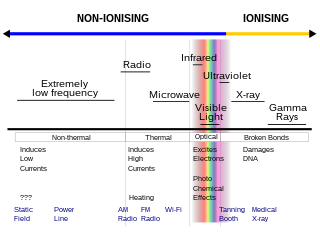
A wireless network is a computer network that uses wireless data connections between network nodes. Wireless networking allows homes, telecommunications networks and business installations to avoid the costly process of introducing cables into a building, or as a connection between various equipment locations. Admin telecommunications networks are generally implemented and administered using radio communication. This implementation takes place at the physical level (layer) of the OSI model network structure.

Electromagnetic radiation can be classified into two types: ionizing radiation and non-ionizing radiation, based on the capability of a single photon with more than 10 eV energy to ionize atoms or break chemical bonds. Extreme ultraviolet and higher frequencies, such as X-rays or gamma rays are ionizing, and these pose their own special hazards: see radiation poisoning. The field strength of electromagnetic radiation is measured in volts per meter (V/m).
Radio frequency (RF) is the oscillation rate of an alternating electric current or voltage or of a magnetic, electric or electromagnetic field or mechanical system in the frequency range from around 20 kHz to around 300 GHz. This is roughly between the upper limit of audio frequencies and the lower limit of infrared frequencies, and also encompasses the microwave range, though other definitions treat microwaves as a separate band from RF. These are the frequencies at which energy from an oscillating current can radiate off a conductor into space as radio waves, so they are used in radio technology, among other uses. Different sources specify different upper and lower bounds for the frequency range.
The microwave auditory effect, also known as the microwave hearing effect or the Frey effect, consists of the human perception of audible clicks, buzzing, hissing or knocking induced by pulsed or modulated radio frequencies. The perceived sounds are generated directly inside the human head without the need of any receiving electronic device. The effect was first reported by persons working in the vicinity of radar transponders during World War II. In 1961, the American neuroscientist Allan H. Frey studied this phenomenon and was the first to publish information on the nature of the microwave auditory effect. The cause is thought to be thermoelastic expansion of portions of the auditory apparatus, although competing theories explain the results of holographic interferometry tests differently.
Multiple chemical sensitivity (MCS), also known as idiopathic environmental intolerances (IEI), is an unrecognized and controversial diagnosis characterized by chronic symptoms attributed to exposure to low levels of commonly used chemicals. Symptoms are typically vague and non-specific. They may include fatigue, headaches, nausea, and dizziness.

Wireless communication is the transfer of information (telecommunication) between two or more points without the use of an electrical conductor, optical fiber or other continuous guided medium for the transfer. The most common wireless technologies use radio waves. With radio waves, intended distances can be short, such as a few meters for Bluetooth or as far as millions of kilometers for deep-space radio communications. It encompasses various types of fixed, mobile, and portable applications, including two-way radios, cellular telephones, personal digital assistants (PDAs), and wireless networking. Other examples of applications of radio wireless technology include GPS units, garage door openers, wireless computer mouse, keyboards and headsets, headphones, radio receivers, satellite television, broadcast television and cordless telephones. Somewhat less common methods of achieving wireless communications involve other electromagnetic phenomena, such as light and magnetic or electric fields, or the use of sound.

Base station is – according to the International Telecommunication Union's (ITU) Radio Regulations (RR) – a "land station in the land mobile service."
Extremely high frequency is the International Telecommunication Union designation for the band of radio frequencies in the electromagnetic spectrum from 30 to 300 gigahertz (GHz). It lies between the super high frequency band and the far infrared band, the lower part of which is the terahertz band. Radio waves in this band have wavelengths from ten to one millimeter, so it is also called the millimeter band and radiation in this band is called millimeter waves, sometimes abbreviated MMW or mmWave. Millimeter-length electromagnetic waves were first investigated by Jagadish Chandra Bose, who generated waves of frequency up to 60 GHz during experiments in 1894–1896.
Specific absorption rate (SAR) is a measure of the rate at which energy is absorbed per unit mass by a human body when exposed to a radio frequency (RF) electromagnetic field. It is defined as the power absorbed per mass of tissue and has units of watts per kilogram (W/kg).

The antennas contained in mobile phones, including smartphones, emit radiofrequency (RF) radiation ; the parts of the head or body nearest to the antenna can absorb this energy and convert it to heat. Since at least the 1990s, scientists have researched whether the now-ubiquitous radiation associated with mobile phone antennas or cell phone towers is affecting human health. Mobile phone networks use various bands of RF radiation, some of which overlap with the microwave range. Other digital wireless systems, such as data communication networks, produce similar radiation.
Electromagnetic hypersensitivity (EHS) is a claimed sensitivity to electromagnetic fields, to which negative symptoms are attributed. EHS has no scientific basis and is not a recognized medical diagnosis, although it is generally accepted that the experience of EHS symptoms is of psychosomatic origin. Claims are characterized by a "variety of non-specific symptoms, which afflicted individuals attribute to exposure to electromagnetic fields". Attempts to justify the claim that EHS is caused by exposure to electromagnetic fields have amounted to pseudoscience.
Arthur Robert Firstenberg is an American author and activist on the subject of electromagnetic radiation and health. He is the founder of the independent campaign group the Cellular Phone Task Force. He is the author of Microwaving Our Planet: The Environmental Impact of the Wireless Revolution and The Invisible Rainbow: A History of Electricity and Life.

In telecommunications, 5G is the fifth-generation technology standard for cellular networks, which cellular phone companies began deploying worldwide in 2019, and is the successor to 4G technology that provides connectivity to most current mobile phones.

Mobile technology is the technology used for cellular communication. Mobile technology has evolved rapidly over the past few years. Since the start of this millennium, a standard mobile device has gone from being no more than a simple two-way pager to being a mobile phone, GPS navigation device, an embedded web browser and instant messaging client, and a handheld gaming console. Many experts believe that the future of computer technology rests in mobile computing with wireless networking. Mobile computing by way of tablet computers is becoming more popular. Tablets are available on the 3G and 4G networks.

Non-ionizingradiation refers to any type of electromagnetic radiation that does not carry enough energy per quantum to ionize atoms or molecules—that is, to completely remove an electron from an atom or molecule. Instead of producing charged ions when passing through matter, non-ionizing electromagnetic radiation has sufficient energy only for excitation. Non-ionizing radiation is not a significant health risk. In contrast, ionizing radiation has a higher frequency and shorter wavelength than non-ionizing radiation, and can be a serious health hazard: exposure to it can cause burns, radiation sickness, many kinds of cancer, and genetic damage. Using ionizing radiation requires elaborate radiological protection measures, which in general are not required with non-ionizing radiation.
Joel M. Moskowitz is a researcher on the faculty of the School of Public Health at the University of California, Berkeley. He has worked on public health issues that include cell phone risk, tobacco control, and alcohol abuse. He helped the city of Berkeley, California to draft an ordinance mandating safety warnings on cell phones. In 2018, Moskowitz won the James Madison Freedom of Information Award for his work in bringing to light previously publicly unknown California Department of Public Health guidance documents about cell phone safety.

Misinformation related to 5G technology is widespread in many countries of the world. The spreading of false information and conspiracy theories has also been propagated by the general public and celebrities. In social media, misinformation related to 5G has been presented as facts, and shared extensively. There are no scientifically proven adverse health impacts from the exposure to 5G radio frequency radiation with levels below those suggested by the guidelines of regulating bodies, including the International Commission on Non-Ionizing Radiation Protection (ICNIRP). Furthermore, studies have shown that there is no noticeable increase in the everyday radiofrequency electromagnetic exposure since 2012, despite the increased use of communication devices.
Michael Harry Repacholi is an Australian biophysicist and radiation protection expert. He is one of the pioneer scientists and foremost authorities in Radiobiology in the world, including radiation protection standards for ionizing radiation and non-ionizing radiation across the electromagnetic spectrum. He was one of the founders and past presidents of the International Commission on Non-Ionizing Radiation Protection (ICNIRP) and founder and director of several projects in the World Health Organization, including the International Electromagnetic Fields (EMF) Project. Repacholi was also active in the study of the health consequences of the Chernobyl accident in the nuclear reactor, in Ukraine.
SEMCAD X Matterhorn is a computer-aided-design-based simulation platform marketed by Schmid and Partner Engineering AG in Zurich, Switzerland. SEMCAD is 3D electromagnetic (EM) simulation software used for numerical assessment of EM interference and compatibility (EMI/EMC), antenna design and optimization, 5G, wireless power transfer (WPT), dosimetry, optics, high-performance computing (HPC), and design of microwave and mm-wave waveguide devices. The software has also been used in research on magnetic resonance imaging safety, especially in the context of EM compatibility of implanted medical devices.







